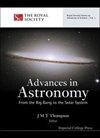星系动物园SDSS螺旋星系自旋方向分布的再分析
IF 1.2
4区 物理与天体物理
Q3 ASTRONOMY & ASTROPHYSICS
引用次数: 2
摘要
在过去的二十年里,斯隆数字巡天中螺旋星系自旋方向的分布一直是一个争论的话题,即使在使用相同数据的情况下,也有相互矛盾的结论。在这里,我们遵循之前的一个实验,应用SpArcFiRe算法对Galaxy Zoo 1的原始数据集中的自旋方向进行注释。星系自旋方向的注释是在选择螺旋星系的第一步之后以三种不同的方式进行的:通过星系动物园分类进行手动分析,通过模型驱动的计算机分析,以及不选择螺旋星系。结果表明,当星系动物园的志愿者选择螺旋星系时,SpArcFiRe确定的螺旋星系的自旋方向分布不是随机的,这与之前的报道一致。当使用模型驱动的计算机分析选择螺旋星系时,或者根本不选择螺旋星系,其分布也不是随机的。简单的二项式分布分析表明,奇偶校验违反偶然发生的概率低于0.01。将从地球观测到的自旋方向拟合为余弦依赖性,显示出统计强度为2.33σ至3.97σ的偶极轴。这些实验表明,无论选择机制和分析方法如何,所有实验都显示出相似的结论。这些结果与之前使用其他方法和望远镜的报告一致,表明从地球上观察到的螺旋星系的旋转方向显示出由其旋转方向形成的偶极轴。可能的解释可能与宇宙的大尺度结构或星系的内部结构有关。作为这项研究的一部分,可以获得注释星系的目录。本文章由计算机程序翻译,如有差异,请以英文原文为准。
Reanalysis of the Spin Direction Distribution of Galaxy Zoo SDSS Spiral Galaxies
The distribution of the spin directions of spiral galaxies in the Sloan Digital Sky Survey has been a topic of debate in the past two decades, with conflicting conclusions reported even in cases where the same data were used. Here, we follow one of the previous experiments by applying the SpArcFiRe algorithm to annotate the spin directions in an original dataset of Galaxy Zoo 1. The annotation of the galaxy spin directions is carried out after the first step of selecting the spiral galaxies in three different manners: manual analysis by Galaxy Zoo classifications, by a model-driven computer analysis, and with no selection of spiral galaxies. The results show that when spiral galaxies are selected by Galaxy Zoo volunteers, the distribution of their spin directions as determined by SpArcFiRe is not random, which agrees with previous reports. When selecting the spiral galaxies using a model-driven computer analysis or without selecting the spiral galaxies at all, the distribution is also not random. Simple binomial distribution analysis shows that the probability of the parity violation to occur by chance is lower than 0.01. Fitting the spin directions as observed from the Earth to cosine dependence exhibits a dipole axis with statistical strength of 2.33
σ
to 3.97
σ
. These experiments show that regardless of the selection mechanism and the analysis method, all experiments show similar conclusions. These results are aligned with previous reports using other methods and telescopes, suggesting that the spin directions of spiral galaxies as observed from the Earth exhibit a dipole axis formed by their spin directions. Possible explanations can be related to the large-scale structure of the universe or to the internal structure of galaxies. The catalogs of annotated galaxies generated as part of this study are available.
求助全文
通过发布文献求助,成功后即可免费获取论文全文。
去求助
来源期刊

Advances in Astronomy
ASTRONOMY & ASTROPHYSICS-
CiteScore
2.70
自引率
7.10%
发文量
10
审稿时长
22 weeks
期刊介绍:
Advances in Astronomy publishes articles in all areas of astronomy, astrophysics, and cosmology. The journal accepts both observational and theoretical investigations into celestial objects and the wider universe, as well as the reports of new methods and instrumentation for their study.
 求助内容:
求助内容: 应助结果提醒方式:
应助结果提醒方式:


